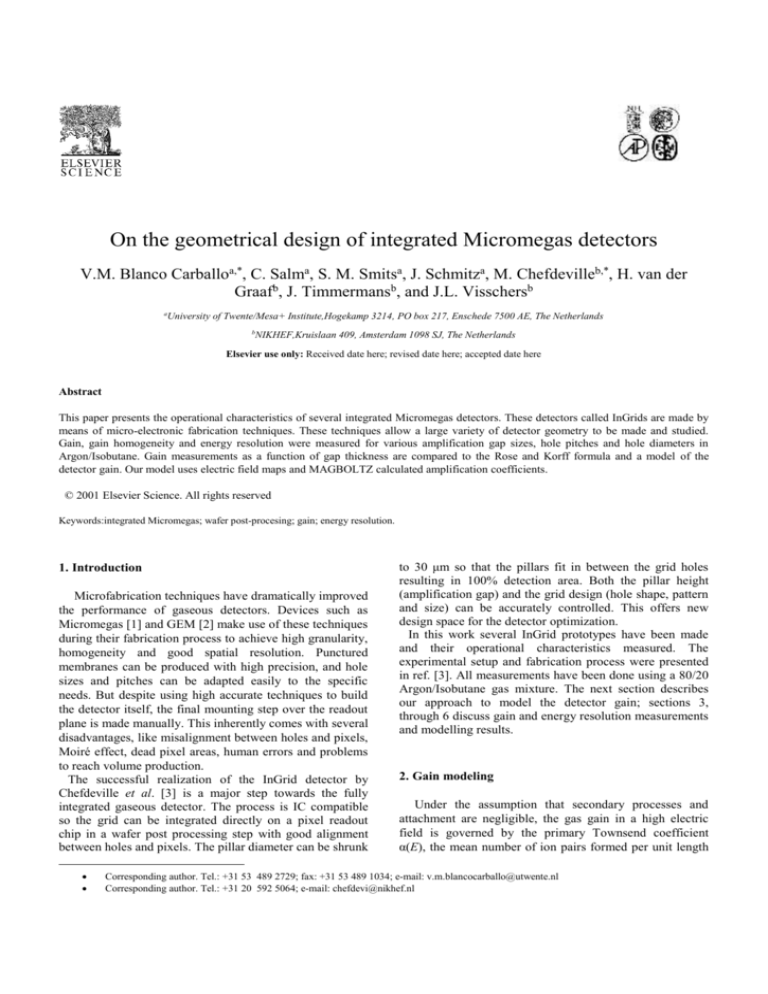
On the geometrical design of integrated Micromegas detectors
V.M. Blanco Carballoa,*, C. Salma, S. M. Smitsa, J. Schmitza, M. Chefdevilleb,*, H. van der
Graafb, J. Timmermansb, and J.L. Visschersb
a
University of Twente/Mesa+ Institute,Hogekamp 3214, PO box 217, Enschede 7500 AE, The Netherlands
b
NIKHEF,Kruislaan 409, Amsterdam 1098 SJ, The Netherlands
Elsevier use only: Received date here; revised date here; accepted date here
Abstract
This paper presents the operational characteristics of several integrated Micromegas detectors. These detectors called InGrids are made by
means of micro-electronic fabrication techniques. These techniques allow a large variety of detector geometry to be made and studied.
Gain, gain homogeneity and energy resolution were measured for various amplification gap sizes, hole pitches and hole diameters in
Argon/Isobutane. Gain measurements as a function of gap thickness are compared to the Rose and Korff formula and a model of the
detector gain. Our model uses electric field maps and MAGBOLTZ calculated amplification coefficients.
© 2001 Elsevier Science. All rights reserved
Keywords:integrated Micromegas; wafer post-procesing; gain; energy resolution.
1. Introduction
Microfabrication techniques have dramatically improved
the performance of gaseous detectors. Devices such as
Micromegas [1] and GEM [2] make use of these techniques
during their fabrication process to achieve high granularity,
homogeneity and good spatial resolution. Punctured
membranes can be produced with high precision, and hole
sizes and pitches can be adapted easily to the specific
needs. But despite using high accurate techniques to build
the detector itself, the final mounting step over the readout
plane is made manually. This inherently comes with several
disadvantages, like misalignment between holes and pixels,
Moiré effect, dead pixel areas, human errors and problems
to reach volume production.
The successful realization of the InGrid detector by
Chefdeville et al. [3] is a major step towards the fully
integrated gaseous detector. The process is IC compatible
so the grid can be integrated directly on a pixel readout
chip in a wafer post processing step with good alignment
between holes and pixels. The pillar diameter can be shrunk
to 30 μm so that the pillars fit in between the grid holes
resulting in 100% detection area. Both the pillar height
(amplification gap) and the grid design (hole shape, pattern
and size) can be accurately controlled. This offers new
design space for the detector optimization.
In this work several InGrid prototypes have been made
and their operational characteristics measured. The
experimental setup and fabrication process were presented
in ref. [3]. All measurements have been done using a 80/20
Argon/Isobutane gas mixture. The next section describes
our approach to model the detector gain; sections 3,
through 6 discuss gain and energy resolution measurements
and modelling results.
2. Gain modeling
Under the assumption that secondary processes and
attachment are negligible, the gas gain in a high electric
field is governed by the primary Townsend coefficient
α(E), the mean number of ion pairs formed per unit length
Corresponding author. Tel.: +31 53 489 2729; fax: +31 53 489 1034; e-mail: v.m.blancocarballo@utwente.nl
Corresponding author. Tel.: +31 20 592 5064; e-mail: chefdevi@nikhef.nl
2
Submitted to Elsevier Science
by an electron at an electric field E. A single electron
traversing a path along the z direction will on average cause
a total gain G of
G e
( E ( z )) dz
(1)
In the case of a homogeneous electric field, α is constant
and the equation simplifies to
G e g
(2)
with g the projected track length (the distance between the
two plates in a parallel-plate geometry).
The electric field in the Micromegas detector is
generally approximated as a composition of a
homogeneous low (drift) field region (Ed) and a
homogeneous high field region (Ea). This assumption
allows to define the field ratio (Ea/Ed) and to model the
collection efficiency and the ion backflow in terms of this
field ratio. In this study we found the precise field shape at
intermediate field strength (i.e. near the foil openings) to be
crucial for the overall detector performance, see sections 3
and 5.
To estimate the gain of a Micromegas detector, the
Townsend coefficient then must be integrated along the
electron drift path. The statistical variation in electron
trajectories and collision phenomena is accounted for by
Monte Carlo calculations as provided by the program
GARFIELD [4], using the electric field maps from
MAXWELL 3D [5] and amplification and drift coefficients
from MAGBOLTZ [6].
For a given gap thickness, the gain homogeneity was
measured to degrade for larger hole diameters. Inversely,
for a given grid geometry, it was improving for smaller gap
thicknesses. We believe the gain to be more sensitive to
hole diameter and gap thickness variations in the case of
bigger holes.
This sensitivity difference was simulated using the
method described in section 2. Gains of a large and a small
hole configuration of 75-m gap were calculated. Same
operation was done for hole diameters and gap thicknesses
differing +/-10% of their original values. Results are
summarized in tables 1,2 and show that the large hole
configuration is more sensitive to diameter variations while
both are almost as sensitive to gap variations.
ΔØ/Ø (%)
ΔG/G (%)
10
19
-10
6
70
10
30
-10
19
Table 1: Gain sensitivity to hole diameter variations.
Hole Ø (m)
36
Δg/g (%)
ΔG/G (%)
10
45
-10
40
70
10
43
-10
38
Table 2: Gain sensitivity to gap thickness variations
Hole Ø (m)
36
4. Gain and gap thickness
3. Gain homogeneity
The microelectronic fabrication techniques (spin
coating, sputtering and wet etching) used to make the
InGrids allow an accurate control of the gap thickness, the
grid thickness and the hole diameter, resulting in a very
good gain homogeneity (defined as the RMS relative
variation of gas gain across a prototype).
For several InGrids, the gain was measured on ten
equally spaced locations across the active area by means of
a collimator. The homogeneity was found to be 10 % in the
worst case and 1.6 % in the best one (Figure 1).
One particularly interesting feature of the Micromegas
detector that can be studied with InGrid is the dependence
of the gain with the gap thickness. For a given grid voltage,
increasing the gap thickness reduces the field but increases
the available amplification length [8]. If equation (1) holds,
the gap thickness dependence of the gain will be governed
by the field dependence of the Townsend coefficient.
An empiric formula valid for low fields was derived by
Rose and Korff [7, 8]:
APe BP / E
(3)
where P is the pressure, E the electric field strength and A
and B constants of the gas mixture. Replacing E by V/g (V
being the grid voltage) and using (1) leads to:
gBP / V
G e gAPe
Figure 1: A 80-m hole pitch, 75-m gap InGrid,
showing 10% gain homogeneity (left side) and a 60-m
hole pitch, 35-m gap InGrid exhibiting 1.6 % gain
homogeneity with a 240 m pillar pitch (right side)
(4)
For a given gas, pressure and grid voltage V, the gain
presents a maximum for a certain gap thickness.
g (Gmax ) V /( BP )
(5)
3
Submitted to Elsevier Science
Selecting the gap thickness according to (5) should
make the gain to a certain extent insensitive to mechanical
imperfections of the mesh (wrinkles) and of the gap
thickness (pillar height variation). This is not a critical
point for the InGrid as gap thickness and grid flatness are
accurately controlled. It is however interesting to check that
there is indeed a gap thickness for which the gain is
maximum.
Several devices with gap thicknesses in the range from
35 μm to 75 μm have been built and gain curves have been
measured. In figure 2 gain curves as a function of the grid
voltage are shown. The gain curves have been fitted using
the Rose and Korff formula.
In figure 3 the dependence of gain with gap thickness is
presented. These measurements were performed at almost
constant atmospheric pressure (variation less than 2%).
5. Gain and grid geometry
Gain as a function of grid geometry has been measured for
three 75 m gap InGrids, each having a different hole
diameter and hole pitch summarized in following Table.
Hole pitch (μm)
Hole diameter (μm)
Gain @ 500 V
InGrid 1
50
32
9800
InGrid 2
60
36
9900
InGrid 3
80
75
2900
Table 3: Measured gain for different InGrid geometries
Figure 4: Gain for three grid geometries (see table above).
Figure 2: Gain as a function of grid voltage for various
gap thicknesses. The data points are fitted using the Rose
and Korff formula (lines).
From Figure 3, it is clear that the Rose and Korff
formula describes the trend well, even though the fit is not
perfect and one requires more measurement points for a
critical assessment. The gas gain reaches its maximum
value for a gap around 50 μm operated with 450 V on the
grid.
The gain is clearly dependent on the hole diameter. This
is understood by looking at the field strength along the hole
axis for different hole diameter, keeping the hole pitch
fixed (Figure 5).While decreasing the hole diameter, the
electric field along the hole axis is higher over a longer
distance, therefore the overall gain increases.
Figure 5: Electric field along the hole axis of a 50-m
gap InGrid for various hole diameters (400 V on the grid).
6. Energy resolution measurements
Figure 3: Gain at 450 V on the grid for various gap
thicknesses. The data points are fitted using the Rose and
Korff formula.
The resolution of gaseous detectors is mainly
determined by the primary charge fluctuations and the
4
Submitted to Elsevier Science
single electron gain fluctuations. These sources are intrinsic
to the sensing gas and cannot be avoided. On the other
hand, fluctuation sources like attachment and collection
efficiency depend on the drift field and can therefore be
optimized for minimum energy resolution.
Energy resolution is calculated using 55Fe spectra. 55Fe
emits quanta of 5.9 keV and 6.5 keV in the ratio 9 to 1.
This ratio is slightly modified to 7.5 to 1, due to the
different absorption of these lines in the gas [7]. Spectra
were fitted using two Gaussian functions (Figure 6). The
parameters (mean, height, width) of the 6.5 keV line were
fixed by the ones of the 5.9 keV line. The energy resolution
is defined as the FWHM of the 5.9 keV line.
of 5.103 could be explained by secondary avalanches
induced by UV photons or space charge effects that distort
the field.
7. Conclusions
The fabrication process of InGrid has reached a mature
level and several InGrids of different geometry have been
made and tested. Excellent homogeneity of the gas gain
across a detector (1.6% RMS) is reported. Gain
measurements for different amplification gap thicknesses
show a good agreement with the Rose and Korff formula.
Energy resolution has been measured to have a minimum at
a gain around 5.103 for three 75-μm gap thickness InGrids
of different hole pitch and diameter. The obtained results
further show that considerable design freedom exists in the
hole shape and diameter.
Acknowledgements
Figure 6: 55Fe spectra in Argon showing the fit of the 5.9
keV and 6.5 keV lines.
For the three grid geometries tabulated in Table 3, the
energy resolution was measured as a function of the grid
voltage. Remarkably, the three curves almost superimpose
when plotted as a function of the gain (Figure 7).
Figure 7: Resolution vs. gain for various hole diameters.
As already noted in [9], the resolution exhibits a
minimum with respect to grid voltage (or gain). An
explanation of the resolution improvement could be the
reduction of avalanche fluctuations when increasing the
amplification field i.e. transition from exponential to Polya
single electron gain fluctuations. Degradation above a gain
This research is funded by the Dutch Foundation for
Fundamental Research on Matter (FOM) and by the Dutch
Technology Foundation STW through project TET 6630
“Plenty of room at the top”. We thank T. Aarnink, D.
Altpeter, H. Jansen, J. Melai and A. Boogaard for all their
productive discussions.
References
[1] Y. Giomataris et al., Nucl. Instr. and Meth. A 376
(1996) 29
[2] F. Sauli, Nucl. Instr. and Meth. A 386 (1997) 531
[3] M. Chefdeville et al., Nucl. Instr. and Meth. A 556
(2006) 490
[4] R. Veenhof, Nucl. Instr. and Meth. A 419 (1998) 726
[5] Ansoft, Maxwell Parameter extractor 3D
[6] S. Biagi, Nucl. Instr. and Meth. A 421 (1999) 234
[7] F. Sauli, CERN yellow report 77-09
[8] Y. Giomataris, Nucl. Instr. and Meth. A 419 (1998) 239
[9] A. Delbart et al., Nucl. Instr. and Meth. A 461 (2001) 84






